light Citroen C4 PICASSO 2016 2.G Owner's Guide
[x] Cancel search | Manufacturer: CITROEN, Model Year: 2016, Model line: C4 PICASSO, Model: Citroen C4 PICASSO 2016 2.GPages: 527, PDF Size: 13.72 MB
Page 86 of 527
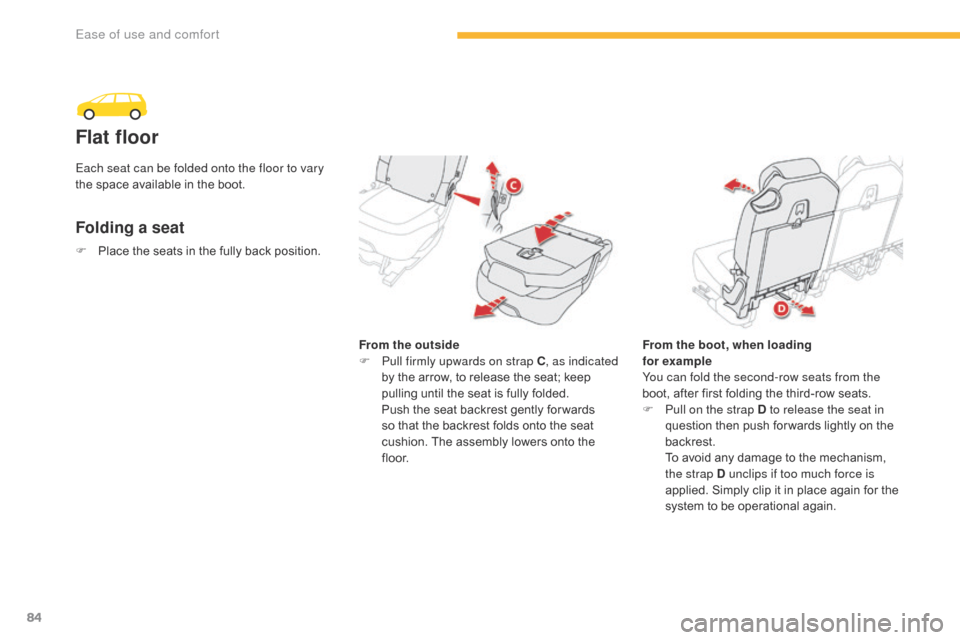
84
C4-Picasso-II_en_Chap03_ergonomie-confort_ed01-2016
Flat floor
Folding a seat
From the outside
F P ull firmly upwards on strap C , as indicated
by
the arrow, to release the seat; keep
p
ulling until the seat is fully folded.
P
ush the seat backrest gently for wards
s
o that the backrest folds onto the seat
c
ushion. The assembly lowers onto the
f
l o o r. From the boot, when loading
for example
You can fold the second-row seats from the
boot,
after first folding the third-row seats.
F
P
ull on the strap D to release the seat in
question
then push for wards lightly on the
b
ackrest.
T
o avoid any damage to the mechanism,
t
he strap D unclips if too much force is
applied.
Simply clip it in place again for the
s
ystem to be operational again.
F
P
lace
the
seats
in
the
fully
back
position.
Each seat can be folded onto the floor to vary
the
space
available
in
the
boot.
Ease of use and comfort
Page 94 of 527
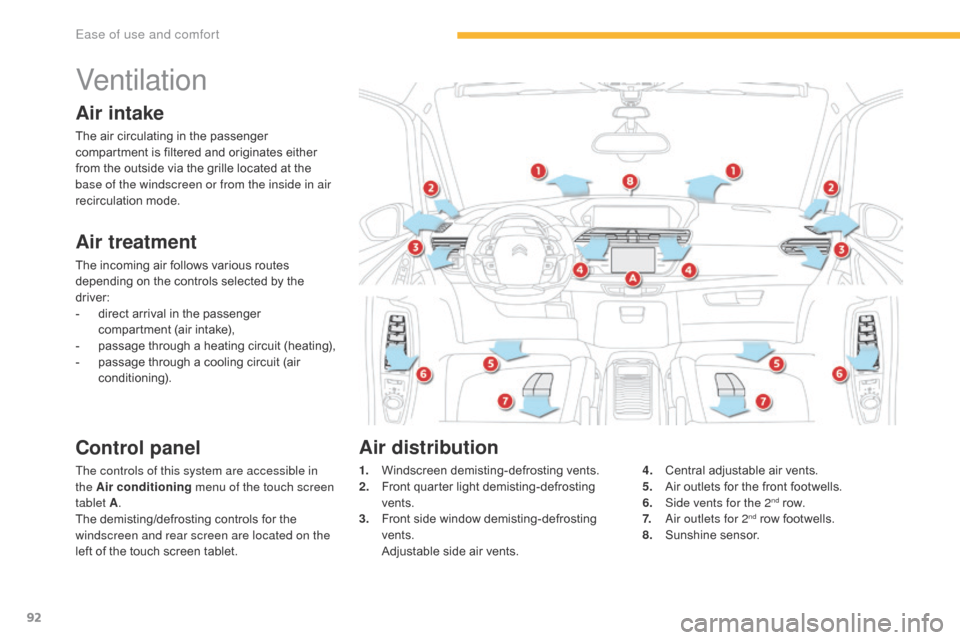
92
C4-Picasso-II_en_Chap03_ergonomie-confort_ed01-2016
Ventilation
Air intake
The air circulating in the passenger compartment is filtered and originates either
f
rom the outside via the grille located at the
b
ase of the windscreen or from the inside in air
recirculation
m
ode.
Air treatment
The incoming air follows various routes depending on the controls selected by the
d
river:
-
d
irect arrival in the passenger
c
ompartment (air intake),
-
p
assage through a heating circuit (heating),
-
p
assage through a cooling circuit (air
c
onditioning).
Control panel
The controls of this system are accessible in
the Air conditioning menu of the touch screen
tablet A .
The
demisting/defrosting controls for the
w
indscreen and rear screen are located on the
left
of the touch screen tablet. 1. W
indscreen d emisting-defrosting v ents.
2. F ront quarter light demisting-defrosting
ve
nts.
3.
F
ront side window demisting-defrosting
ve
nts.
A
djustable side air vents.4. C
entral adjustable air vents.
5. A ir outlets for the front footwells.
6.
S
ide vents for the 2
nd row.
7. A
ir outlets for 2nd row footwells.
8. S
unshine s
ensor.
Air distribution
Ease of use and comfort
Page 108 of 527

106
C4-Picasso-II_en_Chap03_ergonomie-confort_ed01-2016
Sliding sun visor
Sliding blinds are provided for your protection against bright sunlight. They can be adjusted
m
anually.
F
S
lide the blind to the desired position by
pushing
at A.
Sun visor rails
Glove box
Depending on equipment, it may contain a CD p
l aye r.
F
T
o open the glove box, raise the handle.
It
is illuminated when the lid is opened.
It is cooled by a manual directional ventilation
nozzle.
It
is connected directly to your vehicle's air
c
onditioning system and is supplied with cool
a
ir whatever the temperature setting for the
p
assenger
c
ompartment.
The
refrigeration of your glove box operates
o
nly with the engine running and the air
c
onditioning
on
.
The
blinds
are
extended
on
the
sun
visor
rails.
Fold
the
visor
downwards,
to
protect
against
d
azzle
to
the
face.
If
dazzle
is
coming
from
the
side
windows,
d
etach
the
visor
from
its
housing
above
the
c
entre
of
the
windscreen
and
pivot
it
to
the side.
The
visors
are
fitted
with
a
locking
system
on
t
heir
central
housing
when
the
blind
is
reeled
i
n.
To
detach
the
visor
or
to
reposition
it,
it
must
b
e
in
a
vertical
position.
Sliding blinds
Do not attach or suspend heavy objects o n the slide rail of the sun blind.
Ease of use and comfort
Page 110 of 527
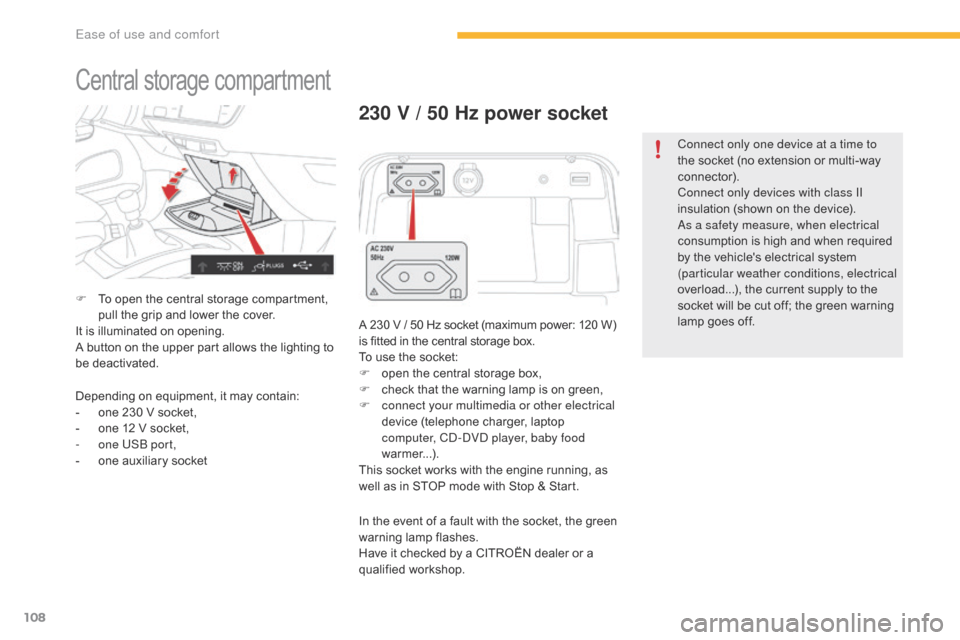
108
C4-Picasso-II_en_Chap03_ergonomie-confort_ed01-2016
Central storage compartment
F To open the central storage compartment, p
ull the grip and lower the cover.
It
is illuminated on opening.
A
button on the upper part allows the lighting to
b
e deactivated.
230 V / 50 Hz power socket
A 230 V / 50 Hz socket (maximum power: 120 W) is fitted in the central storage box.
To
use the socket:
F
o
pen the central storage box,
F
c
heck that the warning lamp is on green,
F
c
onnect your multimedia or other electrical
device
(telephone charger, laptop
c
omputer, CD-DVD player, baby food
warmer...).
This
socket works with the engine running, as
w
ell as in STOP mode with Stop & Start.
Depending
on
equipment,
it
may
contain:
-
o
ne
230
V
socket,
-
o
ne
12
V
socket,
-
o
ne USB port,
-
o
ne
auxiliary
socket In
the event of a fault with the socket, the green
w
arning
lam
p
f
lashes.
Have
it checked by a CITROËN dealer or a
q
ualified
w
orkshop. Connect only one device at a time to
the
socket (no extension or multi-way
c
onnector).
Connect only devices with class II
insulation (shown on the device).
As a safety measure, when electrical
consumption is high and when required
b
y the vehicle's electrical system
(
particular weather conditions, electrical
overload...), the current supply to the
s
ocket will be cut off; the green warning l
amp goes off.
Ease of use and comfort
Page 118 of 527

116
C4-Picasso-II_en_Chap03_ergonomie-confort_ed01-2016
To remove the shelf:
F u nhook the two cords,
F
r
aise the shelf slightly, then remove it.
Rear parcel shelf
There are several options for storing the shelf:
- e ither upright behind the front seats,
-
o
r flat at the base of the boot.The
hooks can be used to secure shopping
b
ags.
Hooks
Ease of use and comfort
Page 123 of 527

121
C4-Picasso-II_en_Chap03_ergonomie-confort_ed01-2016
Courtesy lamps
1. Front courtesy lamp
2. Front map reading lamps
3.
R
ear courtesy lamp
4.
R
ear map reading lamps
Front - rear courtesy lamps
F With the ignition on, press the c
orresponding s witch.
Front - rear map reading
lamps
With the "permanent lighting" mode, the lighting time varies according to the
c
ircumstances:
-
w
ith the ignition off, approximately
t
en minutes,
-
i
n energy economy mode,
a
pproximately thirty seconds,
-
w
ith the engine running, unlimited.
In this position, the courtesy lamp
comes
on
gradually:
Permanently
off.
Permanent
l
ighting.
-
w
hen
the
vehicle
is
unlocked,
-
w
hen
the
electronic
key
is
removed
from
t
he reader,
-
w
hen
opening
a
door,
-
w
hen
the
remote
control
locking
button
is
u
sed,
in
order
to
locate
your
vehicle.
Illumination of the door mirror spot lamps is
only possible if the courtesy lamp is in this
position.
It
switches
off
gradually:
-
w
hen
the
vehicle
is
locked,
-
w
hen
the
ignition
is
switched
on,
-
3
0
seconds
after
the
last
door
is
closed. Take
care to avoid leaving anything in
c
ontact with the courtesy lamps.
3
Ease of use and comfort
Page 124 of 527
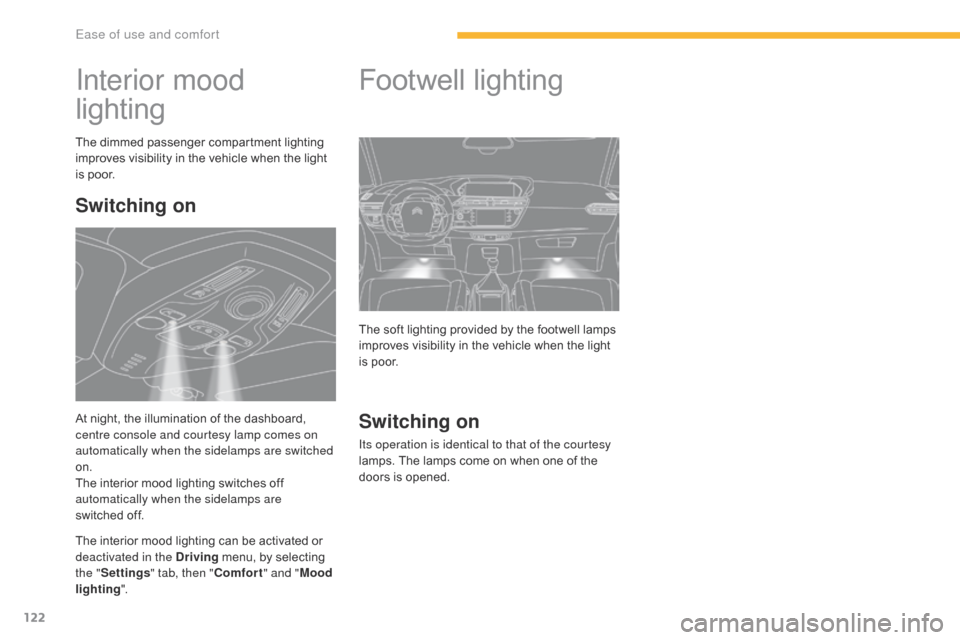
122
C4-Picasso-II_en_Chap03_ergonomie-confort_ed01-2016
Interior mood
lighting
The dimmed passenger compartment lighting improves visibility in the vehicle when the light
i
s poor.
The
interior mood lighting can be activated or
d
eactivated in the Driving
menu, by selecting
t
he " Settings " tab, then " Comfort" and "Mood
lighting ". The
soft lighting provided by the footwell lamps
i
mproves visibility in the vehicle when the light
i
s poor.
At
night, the illumination of the dashboard,
c
entre console and courtesy lamp comes on
automatically when the sidelamps are switched
on.
The
interior mood lighting switches off
a
utomatically when the sidelamps are
switched off.
Switching on
Footwell lighting
Switching on
Its operation is identical to that of the courtesy
lamps. The lamps come on when one of the
d
oors is opened.
Ease of use and comfort
Page 125 of 527
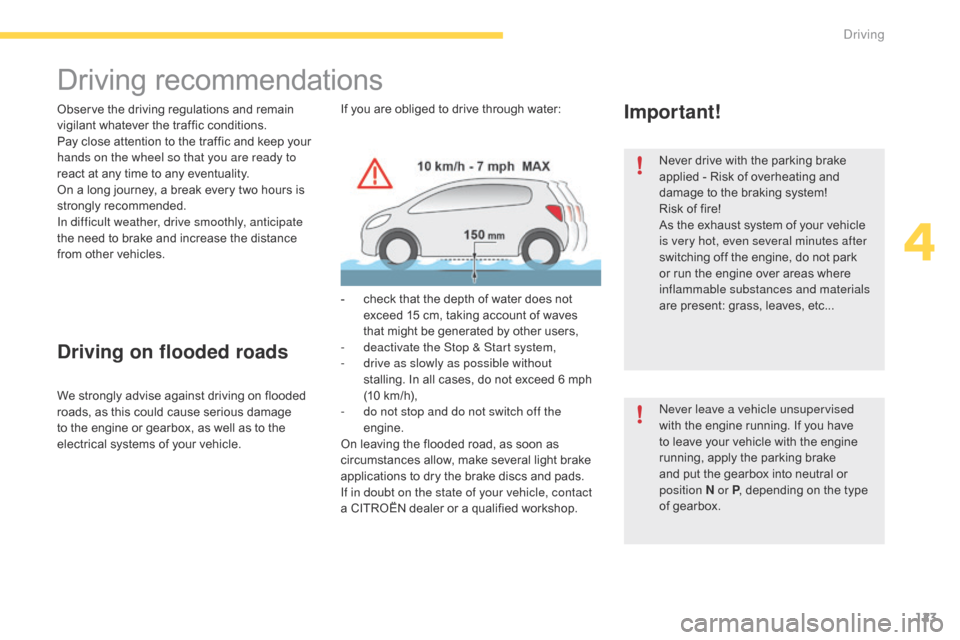
123
C4-Picasso-II_en_Chap04_conduite_ed01-2016
Driving recommendations
Observe the driving regulations and remain vigilant whatever the traffic conditions.
Pay
close attention to the traffic and keep your
h
ands on the wheel so that you are ready to
react
at any time to any eventuality.
On
a long journey, a break every two hours is
s
trongly
re
commended.
In difficult weather, drive smoothly, anticipate
the
need to brake and increase the distance
f
rom other vehicles.
Driving on flooded roads
We strongly advise against driving on flooded roads, as this could cause serious damage
t
o the engine or gearbox, as well as to the
e
lectrical systems of your vehicle.If
you are obliged to drive through water:
-
c
heck that the depth of water does not
e
xceed 15 cm, taking account of waves
t
hat might be generated by other users,
-
d
eactivate the Stop & Start system,
-
d
rive as slowly as possible without
stalling. In all cases, do not exceed 6 mph (
10 km/h),
- d o not stop and do not switch off the
engine.
On
leaving the flooded road, as soon as
c
ircumstances allow, make several light brake
a
pplications to dry the brake discs and pads.
If in doubt on the state of your vehicle, contact
a
CITROËN dealer or a qualified workshop.
Important!
Never drive with the parking brake applied - Risk of overheating and
d
amage to the braking system!
Risk
of fire!
As
the exhaust system of your vehicle
i
s very hot, even several minutes after
switching
off the engine, do not park
o
r run the engine over areas where
in
flammable substances and materials
are
present: grass, leaves, etc...
Never leave a vehicle unsupervised
with
the engine running. If you have
t
o leave your vehicle with the engine
r
unning, apply the parking brake
a
nd put the gearbox into neutral or
p
osition
N or P,
depending on the type
o
f gearbox.
4
Driving
Page 126 of 527
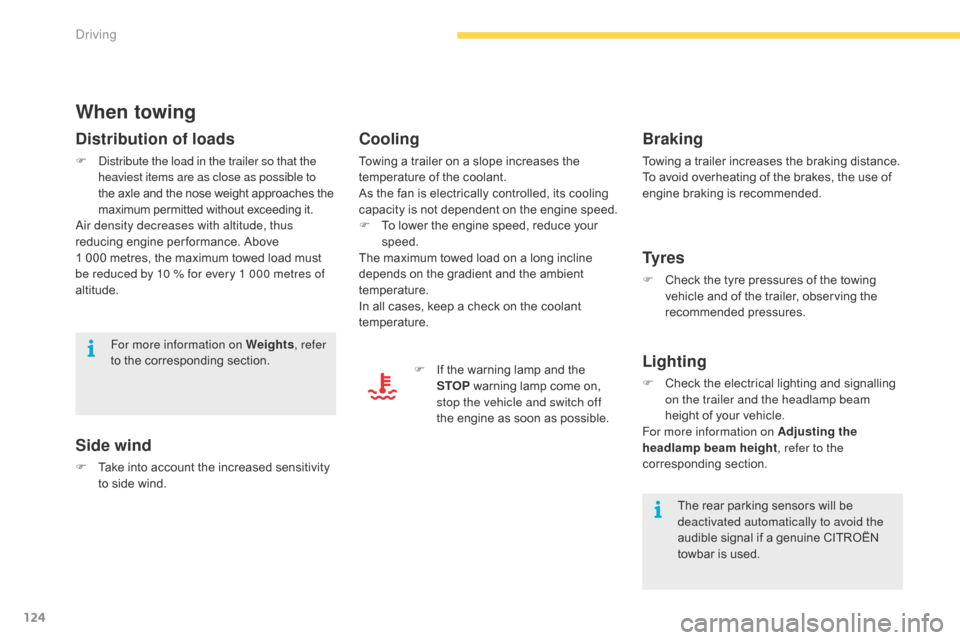
124
C4-Picasso-II_en_Chap04_conduite_ed01-2016
When towing
Distribution of loads
F Distribute the load in the trailer so that the heaviest items are as close as possible to
the
axle and the nose weight approaches the
m
aximum permitted without exceeding it.
Air density decreases with altitude, thus
reducing
engine per formance. Above
1 0
00 metres, the maximum towed load must
b
e reduced by 10 % for every 1 000 metres of
altitude.
Side wind
F Take into account the increased sensitivity t
o side wind.
For more information on Weights
, refer
to the corresponding section.
The rear parking sensors will be
d
eactivated automatically to avoid the
audible
signal if a genuine CITROËN
t
owbar is used.
Cooling
Towing a trailer on a slope increases the temperature of the coolant.
As
the fan is electrically controlled, its cooling
c
apacity is not dependent on the engine speed.
F
T
o lower the engine speed, reduce your
s
peed.
The
maximum towed load on a long incline
d
epends on the gradient and the ambient
t
emperature.
In
all cases, keep a check on the coolant
t
emperature. F
I
f the warning lamp and the
S
TOP
warning lamp come on,
s
top the vehicle and switch off
the
engine as soon as possible.
Braking
Towing a trailer increases the braking distance.
T o avoid overheating of the brakes, the use of
e
ngine braking is recommended.
Ty r e s
F Check the tyre pressures of the towing v
ehicle and of the trailer, observing the
re
commended
p
ressures.
Lighting
F Check the electrical lighting and signalling o
n the trailer and the headlamp beam
height
of your vehicle.
For more information on Adjusting the
headlamp beam height , refer to the
corresponding
s
ection.
Driving
Page 127 of 527

125
C4-Picasso-II_en_Chap04_conduite_ed01-2016
Starting-switching off the engine with the electronic key
F Place the gear selector lever at P or N
for vehicles with an automatic gearbox or
n
eutral with a manual gearbox.
F
I
nsert the electronic key in the reader.
F
P
ress the brake pedal for vehicles with an
a
utomatic gearbox, or fully declutch for
v
ehicles with a manual gearbox.
Starting the engine
For Diesel vehicles, in
temperatures below zero the
engine
will not start until the
p
reheater warning lamp has
g
one off.
If
one
of
the
starting
conditions
is
not
m
et,
a
reminder
message
appears
in
t
he
instrument
panel
screen.
In
some
c
ircumstances, it is necessary to
turn
the
steering
wheel
slightly
while
p
ressing
the
"START/STOP"
button
t
o
assist
unlocking
of
the
steering;
a
message
warns
you
when
this
is
ne
eded. F
B
riefly press the "
START/STOP"
button.
T
he
steering
column
unlocks
and
t
he
engine
starts
more
or
less
i
mmediately (see the advice for
Diesel
v
ersions). If
this
warning lamp comes on after
p
ressing "START/STOP", you should
h
old
the
brake or clutch pedal down
u
ntil
the
warning lamp goes off and
d
o
not
press the START/STOP button
ag
ain.
4
Driving